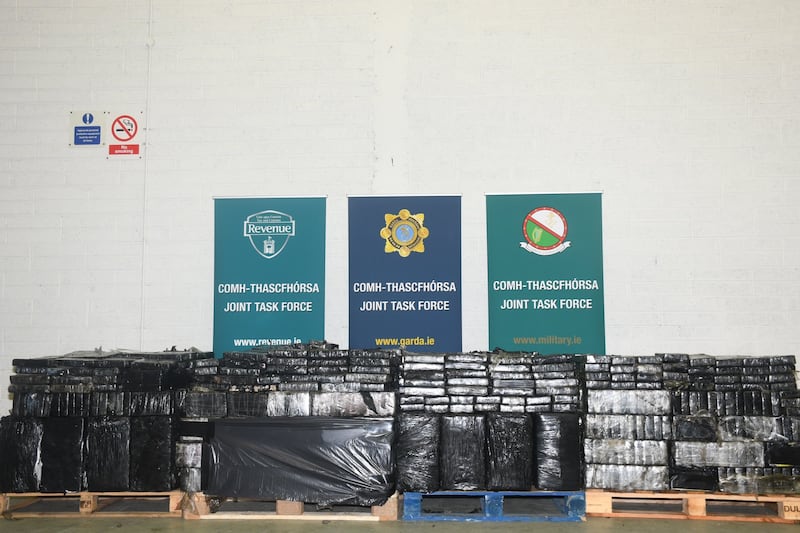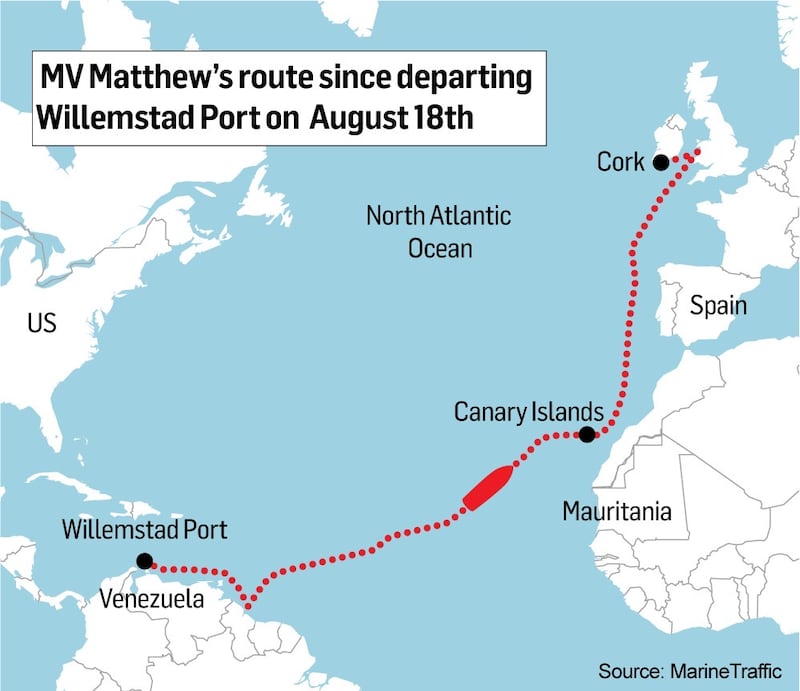“Come aboard as we chart a course towards prosperity and sustainability together,” reads the website of Matthew Maritime, which describes itself as “a leading bulk carrier ship owner company.”
The company’s ships have undertaken 1,200 deliveries and over 1,200 voyages, it claims. But Matthew Maritime is no global leader in shipping. In fact it has one ship, the Panamanian registered MV Matthew, which it purchased six weeks ago.
It was the MV Matthew which was boarded off the coast of Co Cork by the Defence Forces’ Army Ranger Wing and found to be carrying 2.2 tonnes of cocaine, the largest ever seizure in Ireland.
The ship’s recent history is unusual to say the least. Until last month it was called the MV Honmom, with its name only changing while it was already on a voyage from the Dutch island of Aruba in the south Caribbean to Williamstad. It went on to the island of Curaçao and then to Georgetown in Guyana on the North Atlantic coast of South America.
READ MORE
It appears to have collected a cargo around here before sailing across the Atlantic to the Moroccan coast and then north to Ireland. Before this week’s dramatic events, its purported destination was Gdansk in Poland. This later changed to Belfast.
Records show the ship’s owner is headquartered in the Marshall Islands where it shares a business address with multiple shipping companies currently under international sanctions for various reasons.
It was these details, combined with other intelligence, which put the ship on the proverbial radar of the Maritime Analysis and Operations Centre (Narcotics), the Lisbon based multinational drugs agency.
The MV Matthew is just one part of what is believed to be a complex arrangement between a consortium of criminal gangs in multiple countries.
Each of these gangs would likely bring some speciality to the operation, says Jason Eligh, a senior expert at the Global Initiative Against Transnational Organized Crime.
“You’ve got groups that are often good at specific tasks. Maybe you’ve got a group that controls a particular port, and you would need to work with them to get through the port.
“Maybe you’ve got a group that’s really good at transport. You’re looking at a network operation that moves through different nodes or different ports or different landing points.”
The starting point of this network is a Colombian drugs cartel which provided the cocaine to the consortium. Assistant Garda Commissioner Justin Kelly confirmed on Wednesday the drugs came from one of the “murderous” cartels which supplies South American drugs to Europe.

[ South American, Irish and European gangs behind Cork drug ship seizureOpens in new window ]
An Irish gang would have been involved in landing some of the drugs off the south coast, including the purchase of smaller vessels to pick it up from the MV Matthew.
But only a portion of the consignment was destined for these shores. Despite its voracious appetite for cocaine, the Irish market is simply not big enough to absorb 2.2 tonnes of cocaine.
Most of the load was destined for the UK and continental Europe where it was to be distributed by local organised crime groups. These will be the focus of investigations by the French police and the UK’s National Crime Agency which worked with Irish authorities on the interception operation.
So who is the Irish gang? Given the size of the shipment, suspicion will no doubt land on the Kinahan cartel. Gardaí are not so sure. There are multiple groups in Ireland with connections in South America who are capable of carrying out such an operation, Mr Kelly said.
Much will depend on the progress of interviews with the three men currently in Garda custody. These include the MV Matthew’s captain, an Iranian national, and two men, a UK national and an Eastern European, who were rescued off a fishing trawler which gardaí believe was to ferry the drugs to shore.

Investigators are also in the process of interviewing the rest of the MV Matthew’s 25 strong crew, none of whom have been arrested so far.
These interviews will help determine if the MV Matthew was purchased specifically for the purposes of cocaine smuggling or if the drug were hidden aboard without the knowledge of the owners or crew.
“Do organised crime groups purchase vessels for the purpose of maritime drug trafficking? Sure, that has happened in the past. It’s not that uncommon for a group to specialise in this area,” said Mr Eligh with the Global Initiative Against Transnational Organized Crime.
But it is unusual to purchase a vessel the size of a bulk carrier like the MV Matthew, he said.
Criminals prefer to hide drugs in individual containers aboard ships carrying legitimate cargo, he said. “Bananas are very popular”.
It’s likely the MV Matthew was going to unload its cargo on to smaller vessels for transport to the mainland or drop it in the water attached to a GPS tracker for later collection, he said.
“There are lots and lots of ways of getting drugs across the Atlantic in vessels. Really it’s about what works best for you,” Mr Eligh said.
Whoever is behind the shipment, it is certain it represents only a fraction of the cocaine coming into Ireland and Europe, he said. “We’re only seeing a tiny amount of the flows that are going across.”













